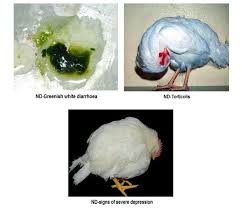Newcastle Disease (ND) is one of the most significant and devastating viral diseases affecting poultry worldwide. Highly contagious and often fatal, this disease poses a constant threat to commercial and backyard flocks, especially in developing countries. Caused by a virulent strain of the avian paramyxovirus type 1 (APMV-1), Newcastle Disease affects birds of all ages and species, with varying degrees of severity.
This article offers an in-depth look into Newcastle Disease, including its causes, symptoms, transmission, diagnosis, prevention, and control strategies.
What is Newcastle Disease?
Newcastle Disease is a viral infection that affects the respiratory, digestive, and nervous systems of birds. It can range in severity from mild to highly fatal, depending on the strain of the virus involved. The disease is reportable to the World Organisation for Animal Health (WOAH, formerly OIE) due to its economic impact and international trade restrictions.
Causative Agent:
The causative virus, avian paramyxovirus serotype 1 (APMV-1), belongs to the genus Avulavirus within the family Paramyxoviridae. The virus has multiple strains categorized based on virulence:
-
Lentogenic (low virulence): Often used in live vaccines
-
Mesogenic (moderate virulence)
-
Velogenic (highly virulent): Causes severe disease and high mortality
Transmission:
Newcastle Disease is highly contagious and spreads rapidly through:
-
Direct contact: with infected birds, secretions, feces, or carcasses
-
Aerosols: Virus can be airborne through dust, droplets, or dander
-
Indirect contact: Contaminated equipment, clothing, feed, and water
-
Vertical transmission: Rare but possible via infected eggs
The virus is resilient and can survive in the environment for weeks, especially in organic material like feces or litter.
Clinical Signs:
Clinical signs of ND vary depending on the strain and host immunity. Symptoms can affect one or more systems:
Respiratory Signs:
-
Sneezing
-
Nasal discharge
-
Coughing
-
Gasping
-
Rales (abnormal breathing sounds)
Digestive Signs:
-
Greenish diarrhea
-
Decreased feed and water intake

Nervous Signs:
-
Twisting of the neck (torticollis)
-
Paralysis of wings or legs
-
Tremors
-
Incoordination
Reproductive Effects:
-
Drop in egg production
-
Misshapen or soft-shelled eggs
-
Infertility in breeders

Mortality:
-
May range from 0% (lentogenic) to 100% (velogenic)
Diagnosis:
Diagnosis of Newcastle Disease involves:
-
Clinical history and signs
-
Post-mortem examination (tracheal congestion, hemorrhages in proventriculus, swollen kidneys)
-
Laboratory confirmation through:
-
Virus isolation (in embryonated eggs)
-
RT-PCR
-
Hemagglutination inhibition (HI) tests
-
ELISA serology
-
Prompt and accurate diagnosis is critical, as ND resembles other avian diseases like avian influenza, infectious bronchitis, and Marek’s disease.
Prevention and Control:
Since there is no specific treatment, prevention through vaccination and biosecurity is the primary defense against Newcastle Disease.
Vaccination Strategies:
-
Live attenuated vaccines: e.g., LaSota and Hitchner B1 (lentogenic)
-
Inactivated vaccines: Used in layers and breeders for long-term protection
-
Schedule: Chicks are typically vaccinated at day-old, with booster doses depending on the risk and production type.
Biosecurity Measures:
-
Restrict farm access and isolate new birds
-
Disinfect housing, equipment, and water systems regularly
-
Control wild birds and rodents
-
Implement all-in, all-out production systems
-
Educate farm workers on hygiene practices
Reporting and Quarantine:
ND is a notifiable disease, and outbreaks must be reported to veterinary authorities for proper containment and control, including possible culling and movement restrictions.
Economic Impact:
Newcastle Disease causes severe economic losses due to:
-
High mortality and morbidity
-
Reduced egg production
-
Trade bans and market restrictions
-
Costs of vaccination and outbreak control
In endemic areas, ND remains one of the top threats to poultry profitability and food security.
Conclusion:
Newcastle Disease remains a major concern in both commercial and rural poultry settings. Due to its rapid spread and high mortality rates, prevention through routine vaccination and strict biosecurity is essential. Veterinary support, farmer education, and surveillance play a crucial role in keeping this disease under control.
Frequently Asked Questions (FAQs):
1. Is Newcastle Disease zoonotic?
Yes, but it’s rare. In humans, ND may cause mild conjunctivitis or flu-like symptoms, typically in people with close contact with infected birds.
2. Can backyard chickens get Newcastle Disease?
Yes. Backyard poultry are highly susceptible due to lack of vaccination and poor biosecurity. They can also serve as reservoirs for spreading the virus.
3. How long does the virus survive in the environment?
The virus can survive for several weeks in organic matter, especially in cool and humid conditions. Sunlight, heat, and disinfectants can inactivate it.
4. How effective is the ND vaccine?
Vaccines are highly effective when administered correctly. However, they do not provide sterilizing immunity — birds may still become infected but usually show reduced clinical signs and mortality.
5. What should I do if I suspect ND in my flock?
Immediately isolate affected birds and inform your local veterinary authorities. Early intervention and testing can help prevent widespread outbreaks.
we offer expert consultation, vaccination plans, and diagnostic services to help poultry farmers protect their flocks from Newcastle Disease and other infectious threats. For more Details Contact us: +92-3315149551 you can also get help from our YouTube Channel.


